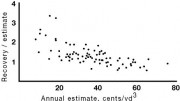This letter was prompted by Brian Hester’s “Odds ‘n’ Sods” article (T.N.M., April 22-28). I worked for Yukon Consolidated Gold Corp. (YCGC) in Dawson City from December 1957 to May 1960, and during the last 17 months of that period, I was general manager.
The consultant to whom Hester refers, and who ended up being “vindicated,” was, I believe, Warren McFarland. McFarland was my mentor at YCGC, and a lifelong, top-notch placer gold mining engineer who in 1934 rejoined YCGC after a 10-year stint in Alaska, where he helped develop a modern gold-dredge operation. As general manager, he did the same for YCGC; he was in charge of the major churn-drilling campaign in the 1930s, to which Hester refers. The positive results of that drilling campaign were the basis for McFarland’s being able to go to London and raise the capital required to reconstruct seven dredges on several creeks in the region, including the giant No. 4 dredge on the Klondike River. This dredge was later dismantled and moved to Bonanza Creek to dig more feet of bedrock than a previous, smaller version had been able to do.
My memory is that year-in and year-out, the YCGC’s overall gold production was 5% better than analysis of the drilling results had predicted.
I should mention another matter: the company knew the dredges recovered 90% of the gold in the gravel and underlying bedrock, the remaining 10% being finely ground “flour” gold. Notwithstanding that McFarland, who previously had retired from his general manager position, “knew” the weight of the equipment required on a dredge to recover the “flour” gold would effectively sink a dredge, an outside director of the company made us perform an independent study of how the remaining 10% gold could be recovered. Again, McFarland was proved right.
Paul Kavanagh
Toronto


Be the first to comment on "Letter to the editor: McFarland was his name"